Mastering the Classic French Vinaigrette: Your Ultimate Guide to Homemade Salad Dressing Perfection
A classic French vinaigrette isn’t just a recipe; it’s a culinary foundation, a skill that elevates every salad and countless other dishes. This essential dressing, born from the simple marriage of quality olive oil, vibrant vinegar, pungent Dijon mustard, and thoughtful seasoning, comes together in mere minutes. Yet, its true genius lies in its remarkable adaptability. Once you grasp the fundamental ratio and technique, you unlock an entire universe of flavor. Consider this your definitive blueprint for crafting a reliable, flexible, and undeniably superior homemade vinaigrette that will render any store-bought bottle obsolete.

Salads grace our tables throughout the year, but they truly become a star during the warmer months. That’s precisely when a fresh, quickly prepared homemade vinaigrette, like this classic French version, truly shines. Beyond its incredible flavor, making your own dressing means you skip the unwelcome preservatives, low-quality oils, and artificial additives often found in bottled alternatives. Whether you prepare a small batch for a single meal or scale it up to last a week, you’ll discover a world of difference. Once you experience the ease and superior taste of homemade, returning to store-bought dressings will be unthinkable. It’s time to embark on your journey to making perfect vinaigrettes right in your own kitchen.
Why You’ll Adore This Easy French Vinaigrette Recipe
This isn’t just another salad dressing; it’s a gateway to better eating and more confident cooking. Here’s why this classic French vinaigrette will become an indispensable part of your culinary repertoire:
- Uncomplicated, Wholesome Ingredients: At its core, this dressing requires only a few basic items: oil, vinegar, Dijon mustard, salt, and pepper. With the optional addition of fresh garlic or shallots, you’re using pure, natural components. This simplicity ensures fresh, vibrant flavors without the need for artificial thickeners, stabilizers, or hidden sugars found in many commercial dressings. You know exactly what’s going into your body.
- Infinitely Customizable and Incredibly Versatile: The beauty of mastering the basic oil-to-vinegar ratio is the freedom it grants you. This classic recipe serves as a perfect foundation, allowing you to effortlessly swap in different oils, vinegars, and seasonings to complement any salad or dish. From a robust balsamic to a delicate Champagne vinegar, or a hint of fresh herbs, the possibilities for customization are truly endless. It’s a chef’s secret for elevating everyday meals.
- Decidedly Superior to Bottled Options: Say goodbye to dressings laden with preservatives, cheap vegetable oils, high fructose corn syrup, or strange gums designed for shelf stability rather than taste. Your homemade French vinaigrette offers unparalleled freshness and a clean, balanced flavor profile that you control entirely. Each batch is a testament to quality, ensuring your salads are dressed with the very best. This is the epitome of a perfect vinaigrette for any salad occasion.
If you’re a particular fan of citrus, my lemon vinaigrette recipe offers a bright and zesty alternative that complements a wide array of Mediterranean-inspired dishes.
Key Ingredients for the Perfect French Vinaigrette
Crafting an authentic French vinaigrette begins with selecting high-quality ingredients. While the list is short, each component plays a crucial role in achieving that perfect balance of tang, richness, and zest.
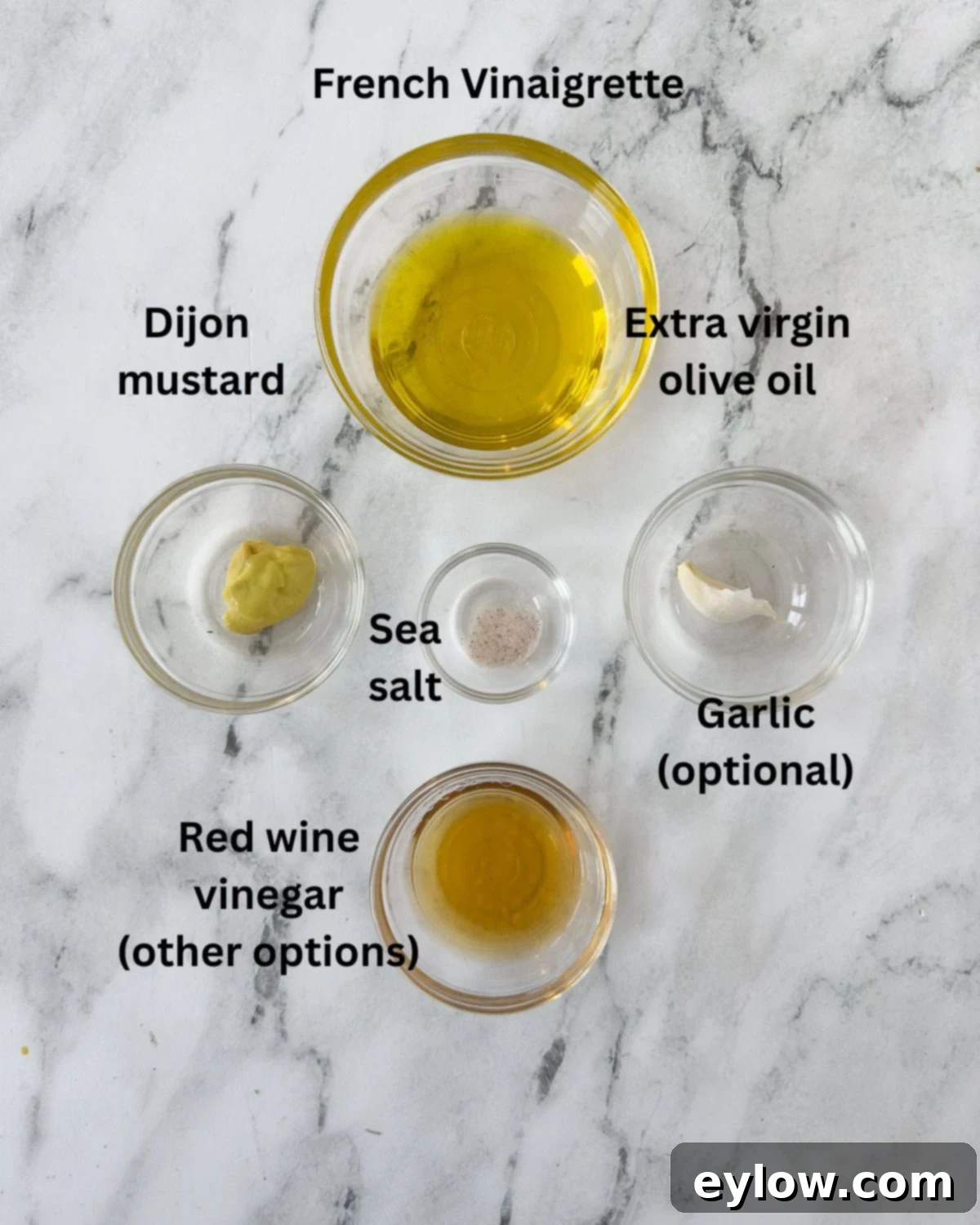
- Extra Virgin Olive Oil: This is the backbone of your vinaigrette. A good quality extra virgin olive oil provides not only the necessary richness and body but also imparts a complex, fruity, or peppery flavor that defines the dressing. Investing in a quality oil truly makes a difference. Look for brands like California Olive Ranch or Calivirgin, which consistently deliver excellent flavor. For customizing your vinaigrette, exploring different olive oil options (see below) can yield exciting results.
- Vinegar: For a truly classic French vinaigrette, red wine vinegar is the traditional and preferred choice. Its robust, slightly fruity acidity gives the dressing its signature tang and brightens all the other flavors. However, this is also an area where you can easily experiment. Below, we’ll explore other vinegar variations that can completely transform your dressing’s character.
- Dijon Mustard: Far from just a flavor enhancer, creamy Dijon mustard is absolutely essential for both the texture and taste of a French vinaigrette. It acts as a natural emulsifier, helping to bind the oil and vinegar together into a smooth, cohesive dressing. Its distinctive piquant flavor adds a wonderful “zip” and depth, preventing the vinaigrette from tasting flat.
- Garlic (optional): A finely minced or zested fresh garlic clove adds a subtle yet profound depth to the vinaigrette. While optional, it introduces a layer of pungent warmth that many find irresistible. If you appreciate a garlicky finish, don’t skip this ingredient.
- Shallot (optional): For an added layer of delicate onion flavor and a touch of texture, finely minced shallots are a superb addition. They offer a milder, sweeter aroma compared to garlic or onions, making them ideal for a sophisticated dressing.
Remember to consult the recipe card for precise measurements of these ingredients, along with the appropriate amounts of sea salt and freshly ground black pepper, which are crucial for seasoning your vinaigrette to perfection.
Unlock Endless Flavors: Substitutions and Variations
The true magic of mastering a homemade French vinaigrette lies in its incredible versatility. By simply swapping out your oils and vinegars, or adding a few extra ingredients, you can create a seemingly endless array of dressings tailored to any dish or mood. This is why my pantry boasts an impressive collection of over nine olive oils and an equal number of vinegars—each offering its unique personality to the mix!
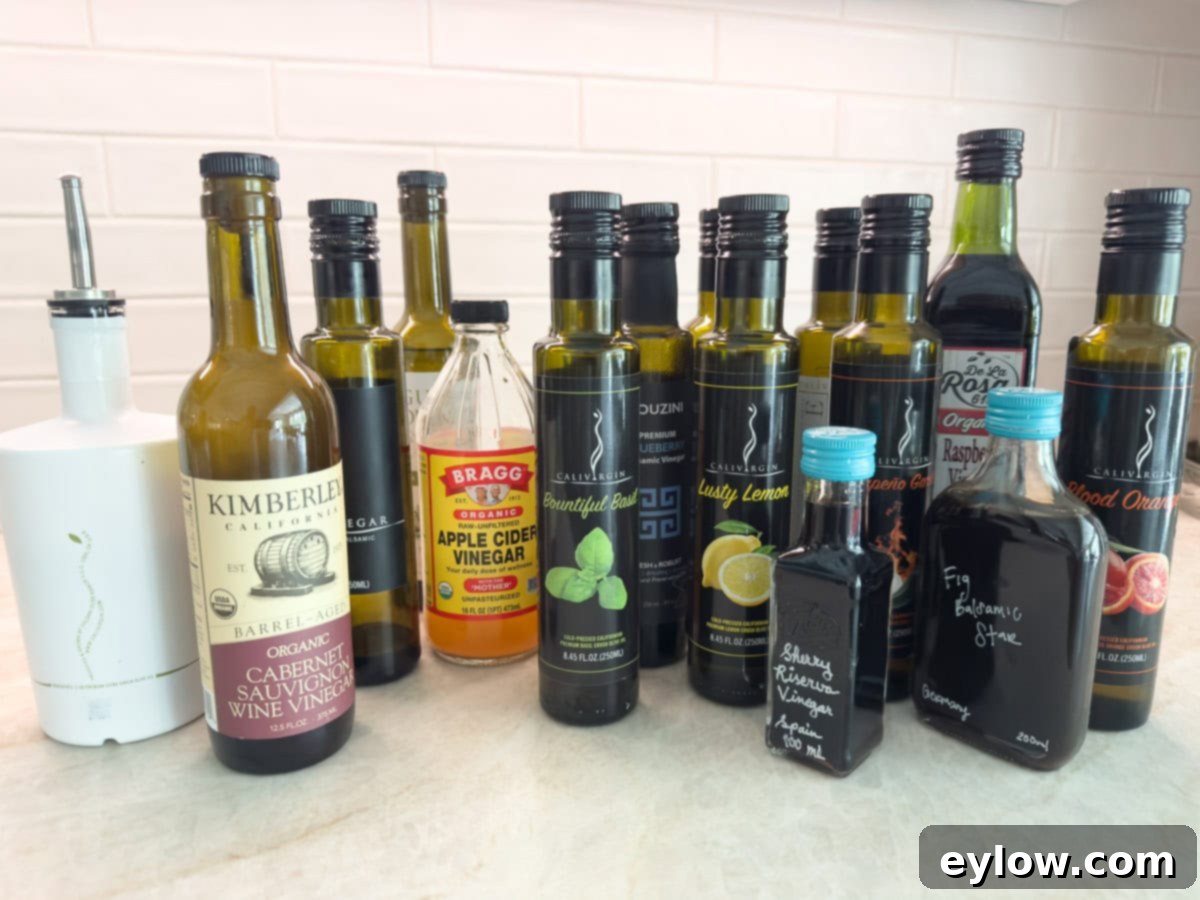
- Oil Alternatives: While extra virgin olive oil is the classic choice, don’t hesitate to explore. Flavored olive oils, infused with lemon, lime, blood orange, or basil, can introduce an incredible depth and aromatic complexity. Beyond olive oil, delicate nut oils like walnut oil or pistachio oil offer distinct, rich undertones, perfect for autumnal salads. For a lighter, more neutral base, consider avocado oil or grapeseed oil. I particularly love using the high-quality flavored California-made oils from Calivirgin for their exceptional purity and taste (no affiliation, just a genuine fan!).
- Vinegar Explorations: Your choice of vinegar significantly impacts the vinaigrette’s character. In addition to the traditional red wine vinegar, try:
- Champagne Vinegar: Offers a delicate, crisp acidity.
- Sherry Vinegar: Provides a nutty, complex flavor, great for Spanish-inspired dishes.
- Rice Vinegar: Milder and slightly sweet, ideal for Asian-inspired salads.
- Apple Cider Vinegar: Adds a bright, fruity tang with a hint of earthy sweetness. A much-used favorite of mine is a German apple cider vinegar.
- White Wine Vinegar: A good all-rounder, similar to red wine vinegar but lighter in flavor.
- White Balsamic Vinegar: Sweeter and less acidic than regular balsamic, with a clearer color.
- Fruit-Infused Vinegars: Raspberry, blueberry, or fig balsamic vinegars add a wonderful fruity sweetness and complexity. I always keep a few on hand for their unique contributions. A good quality basic balsamic is also a pantry staple. Each variety brings something unique to the table, allowing you to tailor your dressing perfectly.
- Mustard Magic: The quality of your Dijon mustard truly makes a difference in a French vinaigrette. After experiencing authentic Dijon in France, I learned to appreciate its depth and emulsifying power. While smooth and creamy Dijon is my go-to for its consistent emulsification and piquant flavor, don’t shy away from whole grain mustards for added texture and a milder spice, or even flavored options like tarragon Dijon for a unique twist. My personal favorite, consistently ranked #1 in taste tests, is Edmond Fallot Dijon from Beaune, France. Maille is another widely available and reliable brand found in most grocery stores.
- Balancing the Tang: If your vinaigrette tastes too sharp or tangy, a small pinch of sugar, a little honey, or a drizzle of maple syrup can effectively balance the acidity, bringing harmony to the flavors without making it overly sweet.
Chef’s Tip: For a delightful citrusy twist and to broaden your flavor spectrum, consider replacing the vinegar entirely with fresh lemon juice, lime juice, or even grapefruit juice. Citrus offers a different kind of bright acidity. You might find you need a slightly larger quantity of citrus juice compared to vinegar to achieve the desired zing, so always taste and adjust as you go until you reach a bright, beautifully balanced flavor profile. Don’t forget the zest for an extra aromatic punch!
For those who love berries, a simple yet exquisite raspberry vinaigrette can be found in this grilled shrimp salad recipe, perfectly enhanced with fresh raspberries.
Effortless Preparation: How to Make a French Vinaigrette
The most liberating aspect of learning to prepare a classic French vinaigrette is that once you grasp the simple formula and its underlying principles, you’ll never again be tethered to a specific recipe. It’s a skill you’ll carry with you, enabling spontaneous culinary creativity.
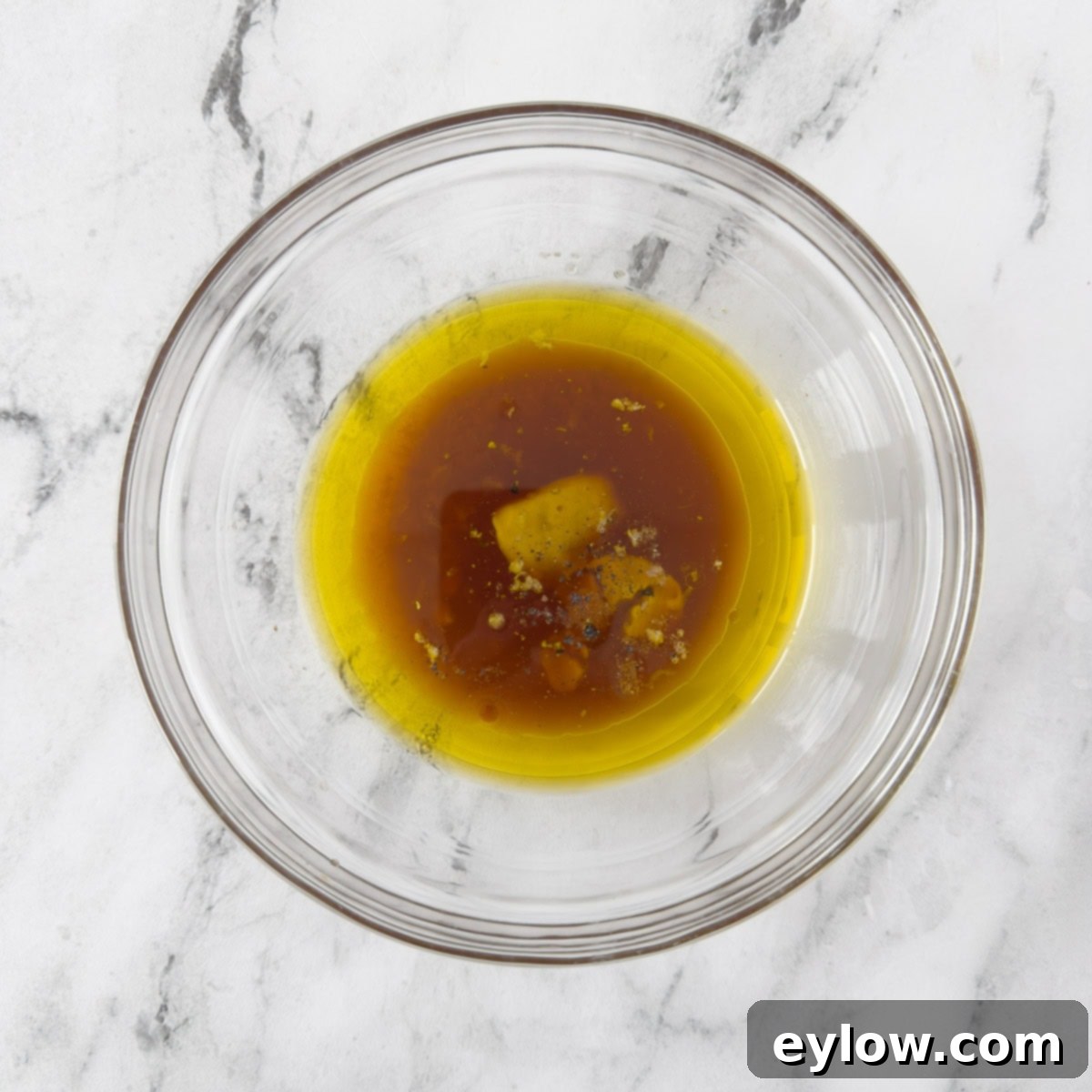
- Combine all your chosen ingredients: oil, vinegar, Dijon mustard, garlic (if using), salt, and pepper into a small bowl.
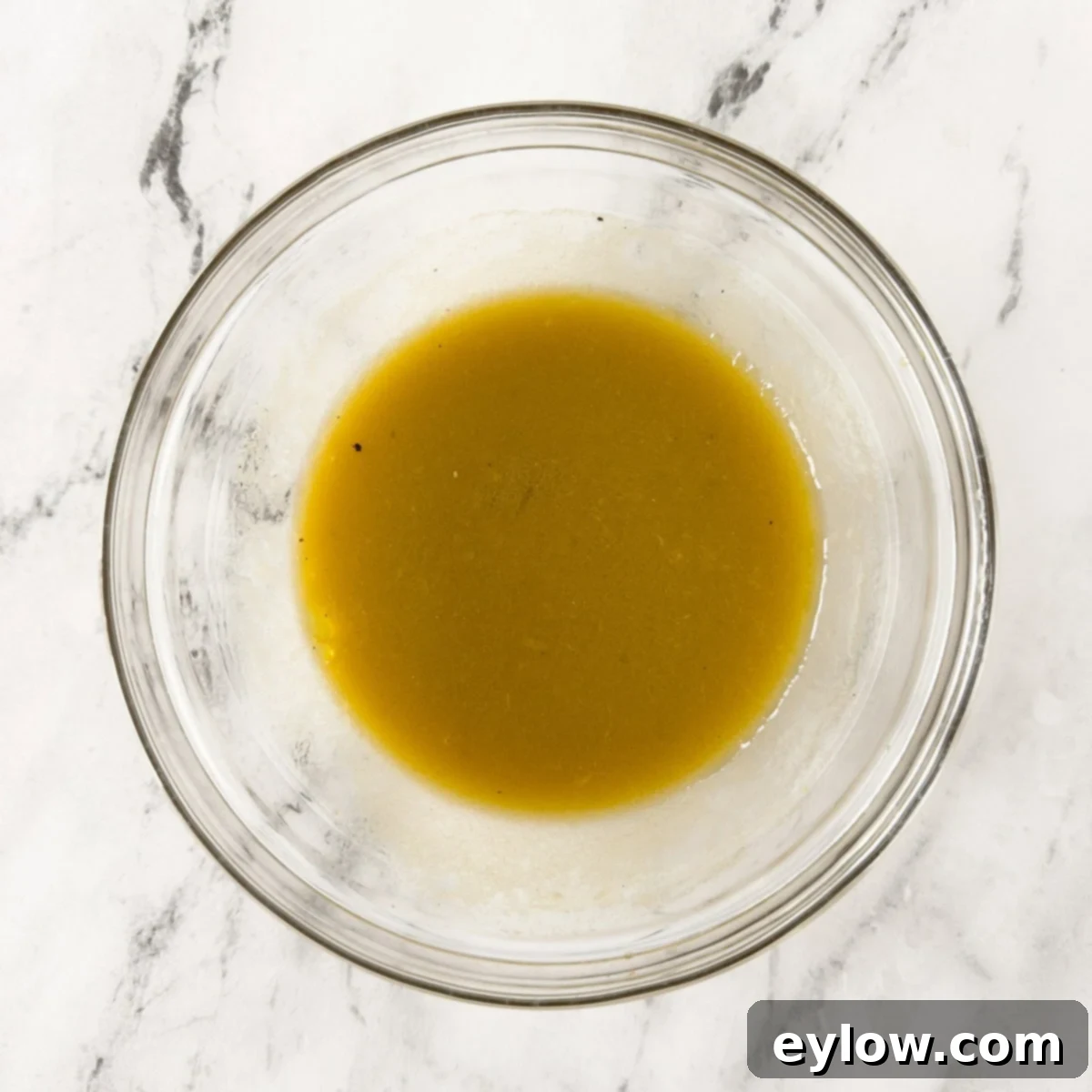
2. Whisk vigorously until the mixture is completely smooth and emulsified. Once blended, transfer your exquisite dressing to a clean jar for storage or immediate use.
While traditional culinary wisdom often dictates slowly drizzling the oil into the vinegar in a steady, thin stream while whisking continuously to form a perfect emulsion—a technique often referred to as “montage”—I honestly find this step unnecessary for small home batches. The exceptional emulsifying power of good quality Dijon mustard readily handles the binding process for you. Simply add all the ingredients to a bowl and whisk until smooth. This straightforward approach consistently yields a homemade vinaigrette that is creamy, perfectly balanced, and bursting with fresh flavor, without any fuss.
For those preparing a modest amount of vinaigrette—just enough to dress a salad for 2 to 4 people—you can even whisk it directly in your salad bowl before adding the greens. This clever trick means one less dish to wash, streamlining your kitchen cleanup!
Alternatively, if you prefer, combine all the ingredients in a jar with a tight-fitting lid and give it a vigorous shake until fully combined and emulsified. This method is particularly convenient for making slightly larger batches. If you desire an exceptionally smooth and slightly creamier texture, or if you’ve added tougher herbs, a quick blitz in a blender will achieve a beautifully emulsified vinaigrette in mere seconds, transforming it into a silky-smooth delight.
Chef’s Garlic Tips: To ensure raw garlic melts seamlessly into your vinaigrette, delivering its pungent flavor without any harsh, chunky bits, use a microplane zester. This tool turns the clove into a fine paste that integrates beautifully. No zester on hand? No problem! Finely mince the garlic, then use the side of your knife blade to mash it against your cutting board with a pinch of salt until it forms a smooth paste. Out of fresh garlic? A small pinch of garlic powder can work as a substitute. Just remember to add it to the dressing a few minutes before serving, allowing it ample time to fully hydrate and “bloom” its flavor.

Serving Your Versatile French Vinaigrette
The beauty of this classic French vinaigrette extends far beyond the traditional green salad. While it’s perfect for lightly coating fresh greens – a gentle toss is always preferred over drenching – its bright, tangy, and rich flavor makes it an incredibly versatile companion for a myriad of dishes. I always recommend serving extra dressing on the side for those who prefer a more generous coating. For the absolute best flavor experience, allow your vinaigrette to come to room temperature before serving, as this allows the flavors to truly bloom.
But please, don’t limit this culinary gem to just simple leafy salads! This vibrant vinaigrette is fantastic for:
- Elevating Salads: Beyond mixed greens, it’s a stellar addition to hearty pasta salads, nutritious bean salads, or even a sophisticated beet salad with feta cheese (as pictured above), where its acidity perfectly cuts through the earthiness of the beets and the richness of the cheese.
- Enhancing Vegetables: Drizzle it over grilled or roasted vegetables like asparagus, broccoli, bell peppers, or zucchini for a burst of fresh flavor. It’s equally delicious on steamed vegetables, adding a gourmet touch to everyday sides.
- Transforming Grain Bowls: A spoonful or two can bring a grain bowl to life, tying together disparate ingredients like quinoa, farro, roasted veggies, and protein into a harmonious meal.
- Marinading Proteins: This vinaigrette makes an exceptional marinade for chicken, fish, or seafood. Its acidic components tenderize the protein while infusing it with incredible flavor before grilling, baking, or pan-searing. It also works wonderfully for marinating tofu or tempeh, adding depth to vegetarian meals.
- As a Finishing Sauce: Use it as a vibrant finishing sauce for cooked meats, poultry, or even scrambled eggs to brighten the dish.
- Dip for Breads or Crudités: A small bowl of this vinaigrette makes a delightful dip for crusty bread or a colorful assortment of fresh crudités.
It’s truly one of those indispensable kitchen staples—a flavor powerhouse that’s endlessly versatile and adds a punch of deliciousness wherever it lands.
Properly Storing Your Homemade Vinaigrette
One of the many benefits of homemade vinaigrette is its freshness, and proper storage ensures you can enjoy it for days. If stored in a tightly sealed jar or airtight container in the refrigerator, your French vinaigrette will maintain its quality for up to a week. Due to the natural separation of oil and vinegar, it’s essential to always give it a good shake or stir vigorously before each use to re-emulsify the ingredients. Additionally, always taste and adjust the seasoning if needed, as flavors can sometimes mellow in the fridge. For optimal flavor, consider taking it out of the refrigerator 15-20 minutes before serving to allow it to come closer to room temperature, which helps release its full aromatic potential.
Chef’s Tip for Freshness: Want to add another layer of complexity and herbaceous brightness? Incorporate tender fresh herbs like finely chopped parsley, tarragon, chives, or dill. Whisk them in at the end for a burst of vibrant flavor and texture, or for a smooth, creamy, and beautifully colored herb-infused vinaigrette, blend everything together. This herbaceous variation is magnificent on not only green salads but also grilled vegetables, roasted potatoes, or even as a zesty dressing for a light chicken salad.

Common Questions About French Vinaigrette
The universally recognized classic ratio for a French vinaigrette is 3 parts oil to 1 part vinegar. This ratio typically provides a balanced flavor that is rich yet tangy. However, this is merely a guideline, not a strict rule. Many chefs and home cooks prefer to adjust this ratio to their personal taste, leaning closer to a 2:1 ratio for a sharper, more acidic dressing, or even slightly more oil for a milder, richer outcome. Don’t hesitate to experiment to find your perfect balance!
While it is possible to make a vinaigrette without Dijon mustard, it’s strongly recommended to include it. Dijon mustard plays a crucial dual role: it provides that distinctive piquant flavor that is characteristic of French vinaigrette, and perhaps more importantly, it acts as an excellent natural emulsifier. The proteins and polysaccharides in mustard help to suspend the oil and vinegar, preventing them from separating too quickly. Without it, your vinaigrette will likely separate more readily, requiring a very vigorous whisk or shake just before serving to re-combine. If you must omit it, you might try adding a tiny pinch of lecithin or a bit of honey to help stabilize the emulsion, though the flavor profile will certainly change.
Absolutely! Using fresh lemon juice (or other citrus juices like lime or even grapefruit) instead of vinegar creates a wonderfully bright, zesty, and refreshing vinaigrette. The acidic profile of lemon juice is different from vinegar, often feeling lighter and more aromatic. When substituting, you might find that you need a little more lemon juice than the amount of vinegar typically called for, so it’s crucial to taste and adjust as you go until you achieve your desired level of tanginess. For an even more intense and aromatic lemon flavor, don’t forget to include some finely zested lemon zest. The zest contains essential oils that impart a powerful, concentrated citrus aroma and flavor, elevating your vinaigrette to new heights.
Separation in vinaigrettes is completely normal, especially when made without strong emulsifiers or after sitting in the fridge. To fix a separated vinaigrette, simply give it a vigorous whisk or a good shake in a sealed jar. The Dijon mustard (if used) will help re-emulsify the dressing quickly. If it’s particularly stubborn, you can add another small dollop of Dijon mustard or a teaspoon of hot water and whisk again. The warmth can sometimes help bring the ingredients back together. For extreme cases, or if you’re aiming for a very stable emulsion, a quick pulse with an immersion blender will do the trick instantly.
A “French” vinaigrette is characterized by its simplicity and precise balance, typically adhering to the 3:1 oil-to-vinegar ratio. The classic version almost always features extra virgin olive oil, red wine vinegar, and Dijon mustard, alongside salt and pepper. While many cultures have their versions of oil-and-acid dressings, the French vinaigrette stands out for its elegant restraint, focusing on high-quality, foundational ingredients without excessive additions. It’s a testament to the French culinary philosophy of letting natural flavors shine.
Explore More Delicious Dressing Recipes
If you’ve enjoyed mastering this classic French vinaigrette, you’ll love expanding your repertoire with these other fantastic homemade dressing recipes:
- Caesar Salad Dressing Without Anchovies
- Creamy Lemon Tahini Dressing
- Easy Homemade Italian Salad Dressing
- Healthy Chicken Salad Recipe with Ginger Salad Dressing
Did You Make This Recipe? We’d Love to Hear From You!
If you’ve taken the plunge and created this delightful French Vinaigrette, we’re eager to hear about your experience! Please take a moment to add your comment and give it a star rating below. Your feedback is invaluable, not only to us but also to other readers who are looking for reliable and delicious recipes. It truly helps our community grow and thrive. If you have any questions during your preparation or about substitutions, please don’t hesitate to ask. Happy cooking!
📖 Recipe
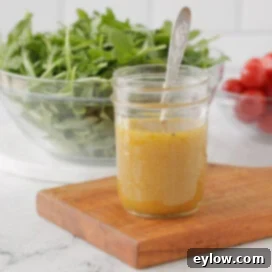
Classic French Vinaigrette
Sally Cameron
Pin Recipe
Equipment
-
French whisk
-
Small bowl
Ingredients
- 6 tablespoons extra virgin olive oil
- 2 tablespoons red wine vinegar vinegar options below
- 1-2 teaspoons Dijon mustard
- 1 small garlic clove optional, zested
- 2 pinches fine sea salt
- 2 pinches ground black pepper
Instructions
-
In a small bowl, whisk all ingredients vigorously until smooth and emulsified, or combine them in a jar with a tight-fitting lid and shake until fully blended. For larger batches or an extra creamy texture, a blender can be used to achieve a perfect emulsion.
Notes
Vinegar options: Don’t limit yourself to red wine vinegar! Experiment with Champagne vinegar for a delicate touch, white wine vinegar for a crisp profile, rich balsamic vinegar, or the fruity tang of apple cider vinegar. Each will impart a slightly different, exciting flavor profile to your dressing. Have fun exploring and finding your favorites!
Oil options: Beyond standard extra virgin olive oil, consider flavored olive oils such as lemon, lime, basil, or blood orange. These infusions add incredible aromatic depth and complexity. Detailed notes and suggestions for various oil choices can be found in the main article!
